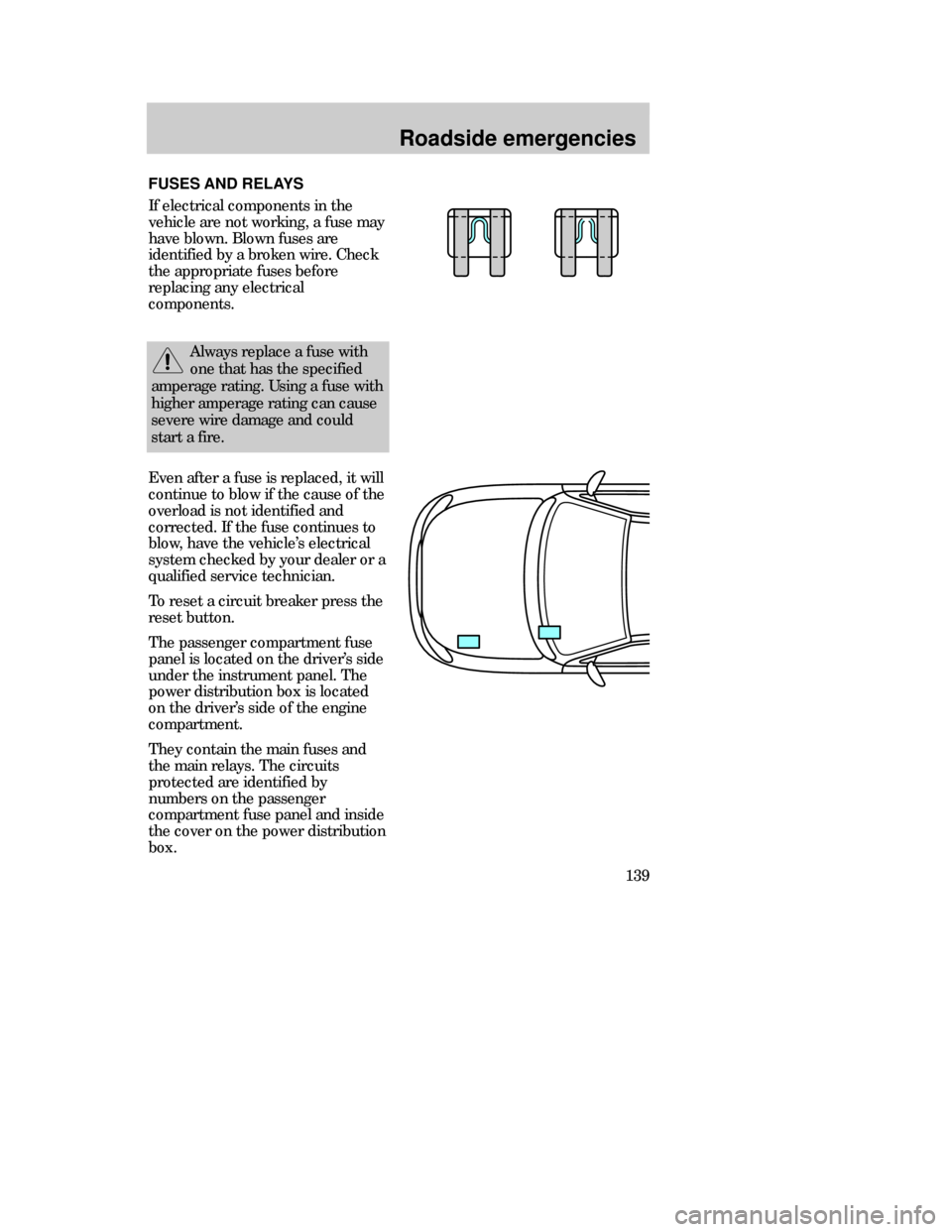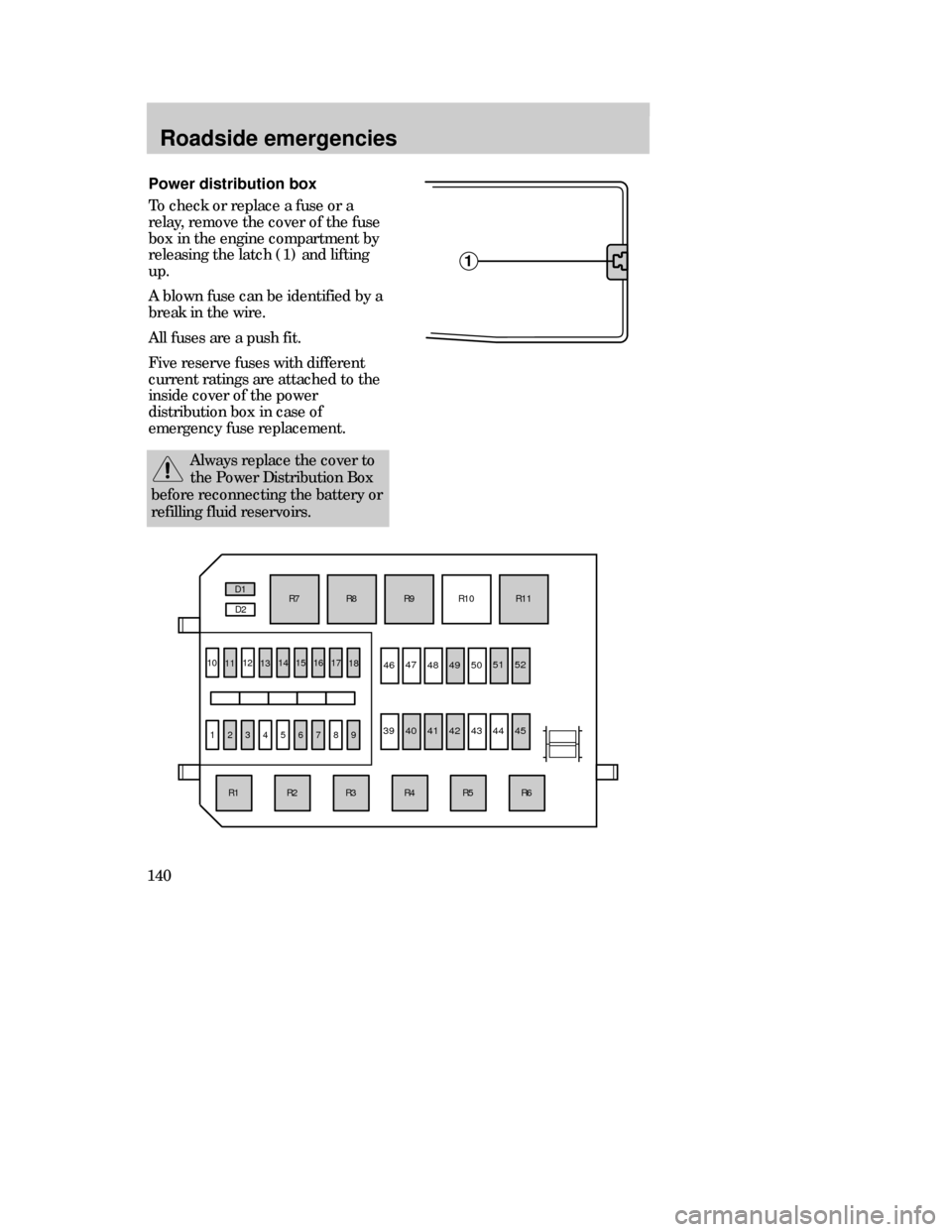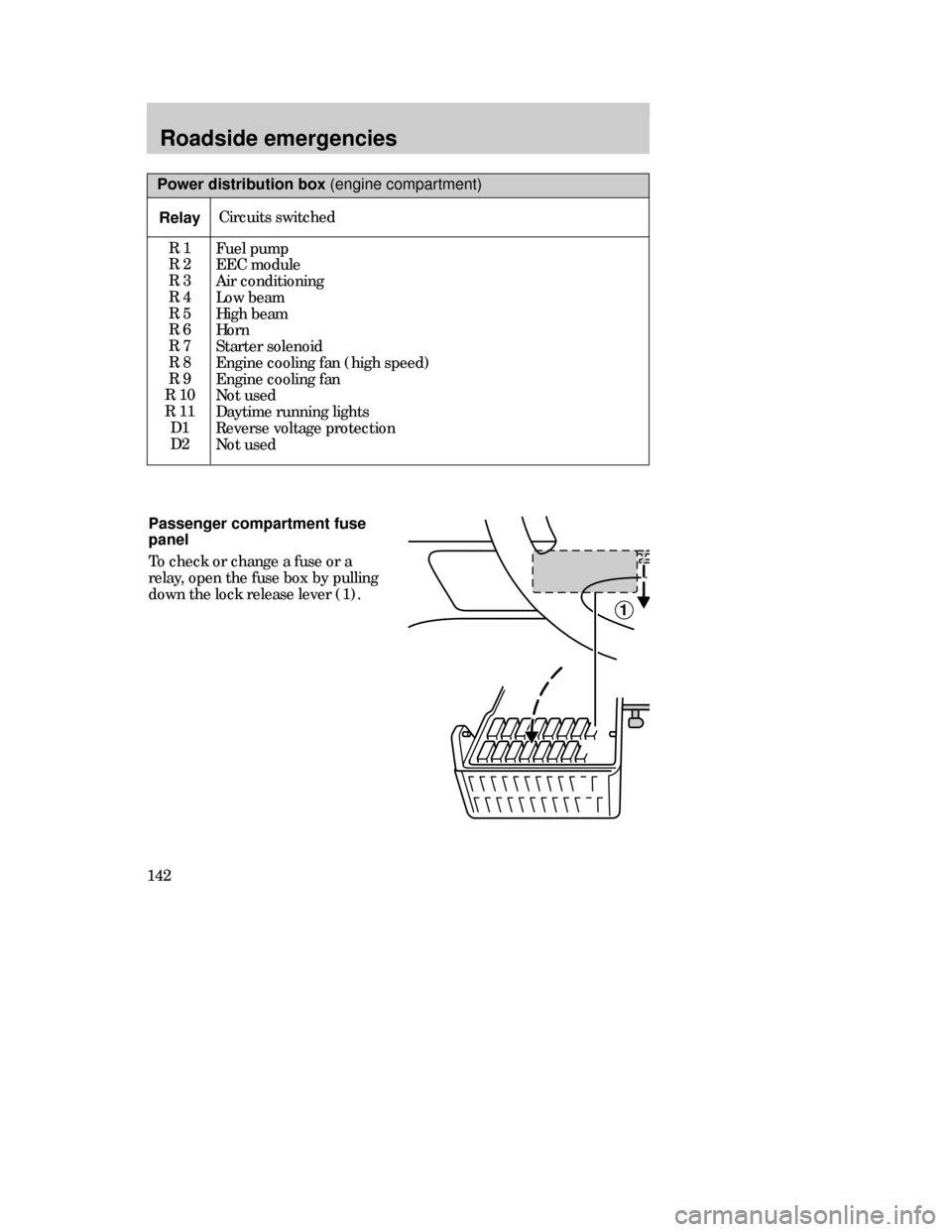check engine Mercury Mystique 1999 s Owner's Guide
[x] Cancel search | Manufacturer: MERCURY, Model Year: 1999, Model line: Mystique, Model: Mercury Mystique 1999Pages: 244, PDF Size: 2.15 MB
Page 57 of 244

Controls and features
57
Do not use the speed control
in heavy traffic or on roads
that are winding, slippery, or
unpaved.
Off
On
Speed control (if equipped)
To turn speed control off
¥ Press Off, or
¥ turn off the vehicle ignition.
Once the speed control is switched
off, the previously programmed set
speed will be erased.
To turn speed control on
¥ Press On.
MIRRORS
OFF LO PNL/FLR
PANEL
A/CFLOOR
DEF FLR
DEF
MAX
A/C HI/
POWER AUDIO AM/FM
SCAN
SEEK 31245ANSSIDE 1-2EJECTVOLUME
000123
000010 20 3040506070
80
90
10 0
110
120
13 0MPH20 406055
80120 10 0
14 0
160
18 0
200EF12
03
x 1000
4
5
6
7
8
BRAKE
CHECK
ENGINE TRACTION
CONTROLO/D
OFF
CLOCK
Res
Set
AccCoastOff
On
TRACTION
TROL
CH
13MCten 4/13/99 3:36 PM Page 57
Page 69 of 244

Controls and features
69
PASSIVE ANTI-THEFT SYSTEM
(if equipped)
The Passive Anti-Theft system
(PATS) is an engine immobilization
system. It is an additional theft
protection feature that prevents
the engine from being started
unless a coded key is used..
This system is only available with
2.5 litre engines.
OFF LO PNL/FLR
PANEL
A/CFLOOR
DEF FLR
DEF
MAX
A/C HI/
POWER AUDIO AM/FM
SCAN
SEEK 31245ANSSIDE 1-2EJECTVOLUME
123
00
7080
90
10 0
110
120
13 0
PH
120
14 0
160
18 0
200
EF
BRAKE
CHECK
ENGINE
CLOCK
Automatic arming
The system is armed five seconds
after switching off the ignition.
The armed status is indicated when
the control light flashes every
two seconds.
Automatic disarming
Switching on the ignition disarms
the system if the correct code is
recognized.
Keys
Your vehicle is supplied with two
coded keys.
Only these keys can be used to
start your vehicle.
13MCten 4/13/99 3:36 PM Page 69
Page 104 of 244

Starting
104
Extended idling at high
engine speeds can produce
very high temperatures in the
engine and exhaust system,
creating the risk of fire or other
damage.
IMPORTANT SAFETY
PRECAUTIONS
A computer system controls the
engineÕs idle revolutions per minute
(rpm). When the engine starts, the
idle rpm runs faster to warm the
engine. If the engine idle speed
does not slow down automatically,
have the vehicle checked by your
dealer or a qualified service
technician. Do not allow the vehicle
to idle for more than ten minutes.
Do not park, idle, or drive
your vehicle in dry grass or
other dry ground cover. The
emission system heats up the
engine compartment and exhaust
system, which can start a fire.
21MSten 4/13/99 2:23 PM Page 104
Page 109 of 244

Starting
109
3. Turn the key to the on position
(without turning the key to start).
Make sure the following lights
illuminate briefly. If a light fails to
illuminate, have the vehicle
serviced by your dealer or a
qualified service technician.
¥ If the driverÕs safety belt is
fastened the safety belt warning
light does not illuminate.
BRAKE
BRAKE
CHECK
ENGINE
Alternative design
Alternative design
O/D
OFFTRACTION
CONTROL
21MSten 4/13/99 2:23 PM Page 109
Page 116 of 244

Driving
116
STEERING YOUR VEHICLE
Your vehicle comes with power
steering. Power steering uses
energy from the engine to help
steer your vehicle.
If the amount of effort needed to
steer your vehicle at a constant
vehicle speed, have the power
steering system checked. If the
power steering system breaks
down (or if the engine is turned
off), you can steer the vehicle
manually but it takes more effort.
Never hold the steering wheel to
the extreme right or left for more
than five seconds if the engine is
running. This can damage the
power steering pump.
Switching off traction control
If you become stuck in snow or on
a slippery road surface, try
switching off the traction control
system by pressing the switch. This
may allow the excess wheel spin to
ÒdigÒ the vehicle out or enable a
successful ÒrockingÒ maneuver. Do
not rock the vehicle for more than
a few minutes, because it could
damage the vehicle.
The light in the control illuminates
continuously when the system has
been switched off. To reactivate
the system, depress the switch
again or restart the engine.
22MDren 4/13/99 3:40 PM Page 116
Page 138 of 244

Roadside emergencies
138
If your engine cranks but does not
start after a collision or substantial
jolt:
1. Turn the ignition key to the off
position.
2. Check under the vehicle for
leaking fuel.
3. If you do not see or smell fuel,
push the red reset button down. If
the button is already set, you may
have a different mechanical
problem.
4. Turn the ignition key to the on
position for a few seconds, then
turn it to the off position.
5. Check under the vehicle again
for leaking fuel. If you see or smell
fuel, do not start your vehicle
again. If you do not see or smell
fuel, you can try to start your
vehicle again.
If you see or smell fuel, do
not reset the switch or try to
start your vehicle. Have all the
passengers get out of the vehicle
and call the local fire department
or a towing service.
23MREen 4/13/99 3:41 PM Page 138
Page 139 of 244

Roadside emergencies
139
Even after a fuse is replaced, it will
continue to blow if the cause of the
overload is not identified and
corrected. If the fuse continues to
blow, have the vehicleÕs electrical
system checked by your dealer or a
qualified service technician.
To reset a circuit breaker press the
reset button.
The passenger compartment fuse
panel is located on the driverÕs side
under the instrument panel. The
power distribution box is located
on the driverÕs side of the engine
compartment.
They contain the main fuses and
the main relays. The circuits
protected are identified by
numbers on the passenger
compartment fuse panel and inside
the cover on the power distribution
box.
FUSES AND RELAYS
If electrical components in the
vehicle are not working, a fuse may
have blown. Blown fuses are
identified by a broken wire. Check
the appropriate fuses before
replacing any electrical
components.
Always replace a fuse with
one that has the specified
amperage rating. Using a fuse with
higher amperage rating can cause
severe wire damage and could
start a fire.
23MREen 4/13/99 3:42 PM Page 139
Page 140 of 244

Roadside emergencies
140
1
Power distribution box
To check or replace a fuse or a
relay, remove the cover of the fuse
box in the engine compartment by
releasing the latch (1) and lifting
up.
A blown fuse can be identified by a
break in the wire.
All fuses are a push fit.
Five reserve fuses with different
current ratings are attached to the
inside cover of the power
distribution box in case of
emergency fuse replacement.
111213141516
R6R5R4R3R2
10
123456789
R1R7R8
R9R10
R11 D1
D2
17
18
4647
4849 5051 52
394041
424344
45
Always replace the cover to
the Power Distribution Box
before reconnecting the battery or
refilling fluid reservoirs.
23MREen 4/13/99 3:42 PM Page 140
Page 142 of 244

Roadside emergencies
142
Passenger compartment fuse
panel
To check or change a fuse or a
relay, open the fuse box by pulling
down the lock release lever (1).
1
Power distribution box (engine compartment)
RelayCircuits switched
R 1
R 2
R 3
R 4
R 5
R 6
R 7
R 8
R 9
R 10
R 11
D1
D2Fuel pump
EEC module
Air conditioning
Low beam
High beam
Horn
Starter solenoid
Engine cooling fan (high speed)
Engine cooling fan
Not used
Daytime running lights
Reverse voltage protection
Not used
23MREen 4/13/99 3:42 PM Page 142
Page 151 of 244

Roadside emergencies
151
3. Park the booster vehicle close to
the hood of the disabled vehicle,
making sure the two vehicles
do
not
touch. Set the parking brake
on both vehicles and stay clear of
the engine cooling fan and other
moving parts.
4. Check all battery terminals and
remove any excessive corrosion
before you attach the battery
cables. Ensure that vent caps are
tight and level.
5. Turn the heater fan on in both
vehicles to protect from any
electrical surges. Turn all other
accessories off.
Connecting the jumper cables
1. Connect the positive (+) booster
cable to the positive (+) terminal of
the discharge battery.
Note:In the illustrations,
Òlightning boltsÓ are used to
designate the assisting (boosting)
battery.
23MREen 4/13/99 3:42 PM Page 151